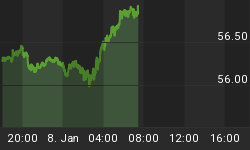SNAP
Stretch that rubber band too far and eventually it breaks.
Dear Speculators,
I often liken the market's movement to a rubber band. Sometimes it moves normally, stretching in reasonable movement both in and out. Sometimes it gets stretched to an extreme. And sometime it breaks. Is this market going to break (or snap) and vault higher, or is it ready to have the natural forces pull it back in?
That's the question we'll try to answer in this weekend's article.
Dynamic Trading Signals are based on a series of Oscillators tuned to the short and intermediate term movement of the market. Our goal is to be in the market at all times and switch from bearish to bullish positions in line with the markets movements (except for the Options service, which is subject to greater volatility and time decay). Periodically we will go to cash and await the next system trade.
DYNAMIC TRADING OSCILLATOR

Discussion: The positioning of this indicator and retesting of higher levels - while not out of the ordinary - is indicative of the market positioning for a top. Eventually this indicator will reach lower levels.
10/20/40 WEEK CYCLE
The following chart shows our 10/20/40 week cycles. The 40 week is also referred to as the 9-month cycle. Cycles are not short term tools for determining precise entry and exit points, they're primarily used for intermediate or longer term positioning and forecasting.

INVESTOR'S INTELLIGENCE BULL BEAR SPREAD
Each week, Investor's Intelligence polls a number of newsletter writers. The poll results in a number of bullish advisors and a number of bearish advisors. The difference between those two numbers produces the following chart. It's believed, that when a majority of newsletter writers (like us) are bullish, that the market is near a top, and vice versa. The direction of this line is as critical as the level.

EQUITY INDEX OPTION VOLUME RATIO
The market is all about risk, and there are two primary classes of participants in the market, the individual investors and the institutions. Individuals primarily trade equity options and institutions primarily trade index options. So the relationship between the two gives us an idea of how much risk the individual is willing to take on. At tops, the individual tends to take on too much risk, making this indicator rise. At bottoms, the individual is usually washed out of the market, making this indicator fall.

QQQQ v. SPY RELATIVE STRENGTH
Risk tells us a lot about the market. This indicator looks at risk from another perspective. When market participants overall increase their willingness to take on risk, it's bullish for the market. That risk shift is shown on the above chart as a shift in relative strength from the Nasdaq to the NYSE. Note when we refer to Nasdaq, we're primarily looking at the QQQQ - since that's the focus of our service. And when we say NYSE, we look at the SPY.

MONEY FLOW
This indicator looks at the flow of money in and out of various investment vehicles. For the most part, when money flow reaches an extreme, in either buying or selling, the market is at a top or a bottom, respectively.

NDX CHART

In summary:
Dynamic Trading remains on its current SELL SIGNAL.
While our entry on the current position was good, for a day, 2 days later, the market had a large move above our entry and above the previous swing. However, given the extended nature of our indicators, we opted to remain short. The market moved sideways for the following 5 days and rallied the last two days to leave us where we are.
Should the last trade have been stopped out? Should we be positioned long? Sure, in hindsight, it was the wrong decision to remain short. However, "would've, could've and should've" have no place in trading. We will experience losses. It is part of trading. Sometimes we'll have more losses than wins and sometimes we'll have more wins than losses. That being said.
The NDX has hit a downtrend line. Sure it could make a dramatic stand and break through this resistance, but it advanced Friday on lighter volume. Not what you want to see when you're about to test a longer term downtrend. Granted, in trading, price trumps volume - mainly because you don't get paid based on a stocks volume - and because the market can keep going up on lighter volume.
The main risk I see is that the NYSE side of the market technically looks to want to test a series of rising tops from last July to this April.
So as painful as it can be fighting the market - we do expect a retracement and if we don't get one on Monday, we will issue specific instructions to exit positions.
Best regards and good trading!
















